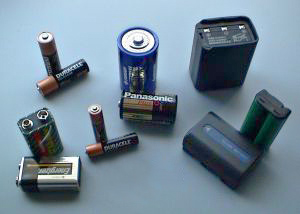A battery is an electric device which stores chemical energy and converts it to electric energy; it will give voltage which can be used as a source of energy. Batteries consist of two cells inside many voltaic cells. There are two major types of battery used mostly, primary and secondary. The primary battery gives current from the chemical energy inside it but this type can’t be reused and you can’t recharge it too. So it’ll be no use when the power inside is exhausted; it’s for one use only then you have to replace it. The secondary battery (storage) gives current from the chemical energy inside it and this type can be reused and it’s rechargeable too. “Although the term “battery” is properly applied to a group of two or more electrochemical cells connected together electrically, both single-cell and multicell devices are called a battery”.( http://0-www.accessscience.com.library.hct.ac.ae/content.aspx?id=075200 )
The main usage of a primary battery is that it’s used as a portable device which requires low current voltages and doesn’t support main source power like alarms ,a hand or pocket flashlight or any device which has a battery slot. “Common types of disposable batteries include zinc-carbon batteries and alkaline batteries. Generally, these have higher energy densities than rechargeable batteries, but disposable batteries do not fare well under high-drain application.” ( http://en.wikipedia.org/wiki/Battery_(electricity) ). These type of batteries can’t be recharged because the chemical reaction cannot return to its original form after usage.
The secondary battery must always be recharged before using it. The secondary battery can be recharged by applying electric current after placing the battery in its special base dock . “This battery is notable in that it contains a liquid in an unsealed container, requiring that the battery be kept upright and the area be well ventilated to ensure safe dispersal of the hydrogen gas produced by these batteries during overcharging.” ( http://en.wikipedia.org/wiki/Battery_(electricity) ).
There're many types of batteries made nowadays. As for primary batteries, there's zinc-carbon which is mainly used in remote controls and flashlights. The main feature is that it's cheap and has low energy density.Lithium-iron sulfide batteries are mainly used in digital cameras and small appliances which are high energy density and expensive. Primary batteries cannot be recharged. As for secondary batteries there's lead-acid which is used mostly for children's electric vehicles and emergency power supply.Lithium-ion battery is used in cellular telephones and portable computers. They have higher energy density and are expensive."The Italian physicist Alessandro Volta is generally credited with having developed the first operable battery." ( http://www.britannica.com/EBchecked/topic/56126/battery)
The main idea of how the battery works is that it converts the chemical energy to electric energy. Inside the battery there are many voltaic cells; each voltaic cell has two half cells connected in series which contain anions and cations. “One half-cell includes electrolyte and the electrode to which anions (negatively charged ions) migrate, i.e., the anode or negative electrode; the other half-cell includes electrolyte and the electrode to which cations (positively charged ions) migrate, i.e., the cathode or positive electrode” ( http://en.wikipedia.org/wiki/Battery_(electricity) ). The electrodes don’t touch each other but they are connected electrically by the electrolyte. Many cells use two half cells with different electrolytes. Every half-cell is put in a container and a separator that separate it from ions. Each half-cell has an electromotive force that drives electric current from the interior to the exterior cell. The electrical driving force across the terminals of the batteries cell is called the terminal voltage and is measured in volts. The volts develop across the terminal cells depending on the energy given from the chemical reactions of the electrodes and electrolyte.
Bibliography:
Donald L. Anglin, Donald R. Sadoway, "Battery," in AccessScience, ©McGraw-Hill Companies, 2008, http://www.accessscience.com from http://0-www.accessscience.com.library.hct.ac.ae/content.aspx?searchStr=batteries&id=075200
Alkaline Manganese, Dioxide Handbook and Application Manual, Energizer, Retrieved 25 August 2008. from http://en.wikipedia.org/wiki/Battery_(electricity)
Encyclopædia Britannica, Brooke Schumm,
http://www.britannica.com/EBchecked/topic/56126/battery
604 words
There're many types of batteries made nowadays. As for primary batteries, there's zinc-carbon which is mainly used in remote controls and flashlights. The main feature is that it's cheap and has low energy density.Lithium-iron sulfide batteries are mainly used in digital cameras and small appliances which are high energy density and expensive. Primary batteries cannot be recharged. As for secondary batteries there's lead-acid which is used mostly for children's electric vehicles and emergency power supply.Lithium-ion battery is used in cellular telephones and portable computers. They have higher energy density and are expensive."The Italian physicist Alessandro Volta is generally credited with having developed the first operable battery." ( http://www.britannica.com/EBchecked/topic/56126/battery)
The main idea of how the battery works is that it converts the chemical energy to electric energy. Inside the battery there are many voltaic cells; each voltaic cell has two half cells connected in series which contain anions and cations. “One half-cell includes electrolyte and the electrode to which anions (negatively charged ions) migrate, i.e., the anode or negative electrode; the other half-cell includes electrolyte and the electrode to which cations (positively charged ions) migrate, i.e., the cathode or positive electrode” ( http://en.wikipedia.org/wiki/Battery_(electricity) ). The electrodes don’t touch each other but they are connected electrically by the electrolyte. Many cells use two half cells with different electrolytes. Every half-cell is put in a container and a separator that separate it from ions. Each half-cell has an electromotive force that drives electric current from the interior to the exterior cell. The electrical driving force across the terminals of the batteries cell is called the terminal voltage and is measured in volts. The volts develop across the terminal cells depending on the energy given from the chemical reactions of the electrodes and electrolyte.
Bibliography:
Donald L. Anglin, Donald R. Sadoway, "Battery," in AccessScience, ©McGraw-Hill Companies, 2008, http://www.accessscience.com from http://0-www.accessscience.com.library.hct.ac.ae/content.aspx?searchStr=batteries&id=075200
Alkaline Manganese, Dioxide Handbook and Application Manual, Energizer, Retrieved 25 August 2008. from http://en.wikipedia.org/wiki/Battery_(electricity)
Encyclopædia Britannica, Brooke Schumm,
http://www.britannica.com/EBchecked/topic/56126/battery
604 words

No comments:
Post a Comment